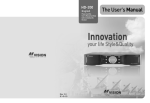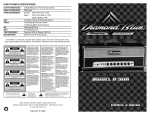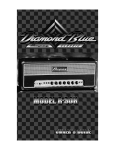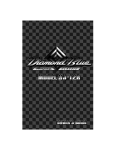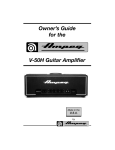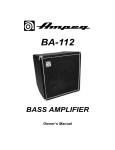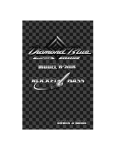Download Ampeg R-12R Specifications
Transcript
R-12R/R-212R TECHNICAL SPECIFICATIONS OUTPUT POWER RATING SIGNAL TO NOISE RATIO POWER REQUIREMENTS 50 Watts RMS @ 10 % THD 8 ohm load 120 VAC 65dB Typical Domestic: 100/120 VAC, 60 Hz, 115VA Export: 220/240 VAC, 50 Hz, 115VA 60 dB Clean channel, 95 dB Overdrive channel 24 dB Range @ 5 kHz Clean channel, 24 dB Range @2kHz Overdrive Channel 8 dB Range @ 700 Hz 24 dB Range @ 40 Hz 12”, 50 w, 8 ohm, 1.5” voice coil diameter, 34 oz. magnet (R-12R = 1, R-212R = 2) R-12R: 24” W x 19” H x 11” D, 45 lbs. R-212R: 27.75”W x 19” H x 12”D, 55 lbs. GAIN TREBLE MID BASS SPEAKER SPECS SIZE AND WEIGHT CAUTION ATTENTION VORSICHT RISK OF ELECTRIC SHOCK DO NOT OPEN RISQUE D'ELECTROCUTION NE PAS OUVRIR ELEKTRISCHE SCHLAGGEFAHR NICHT OFFENEN CAUTION: TO REDUCE THE RISK OF ELECTRIC SHOCK, DO NOT REMOVE COVER. NO USER-SERVICEABLE PARTS INSIDE. REFER SERVICING TO QUALIFIED SERVICE PERSONNEL. ATTENTION: POUR REDUIRE D'ELECTROCUTION NE PAS ENLEVER LE COUVERCLE. AUCUNE PIECE INTERNE N'EST REPRABLE PAR L'UTILISATEUR. POUR TOUTE REPARATION, S'ADRESSER A UN TECHNICIEN QUALIFIE. VORSICHT: ZUR MINIMIERUNG ELEKTRISCHER SCHLAGGEFAHR NICHT DEN DECKEL ABENHMEN. INTERNE TEILE KONNEN NICHT VOM BENUTZER GEWARTET WERDEN. DIE WARTUNG IS QUALIFIZIERTEM WARTUNGSPERSONAL ZU UBERLASSEN. THIS EQUIPMENT HAS BEEN DESIGNED AND ENGINEERED TO PROVIDE SAFE AND RELIABLE OPERATION. IN ORDER TO PROLONG THE LIFE OF THE UNIT AND PREVENT ACCIDENTAL DAMAGES OR INJURY, PLEASE FOLLOW THESE PRECAUTIONARY GUIDELINES: CAUTION: TO REDUCE THE RISK OF ELECTRIC SHOCK, DO NOT OPEN CHASSIS; DO NOT DEFEAT OR REMOVE THE GROUND PIN OF THE POWER CORD; CONNECT ONLY TO A PROPERLY GROUNDED AC POWER OUTLET. WARNING: TO REDUCE THE RISK OF FIRE OR ELECTRIC SHOCK, DO NOT EXPOSE THIS EQUIPMENT TO RAIN OR MOISTURE. CAUTION: NO USER-SERVICEABLE PARTS INSIDE. REFER SERVICING TO QUALIFIED SERVICE PERSONNEL. CAUTION: IF YOU USE AUDIO AMPLIFIERS PROFESSIONALLY OR IN WORK RELATED SITUATIONS AS AN EMPLOYEE, THE OCCUPATIONAL SAFETY AND HEALTH ADMINISTRATION (OSHA) HAS SPECIFIED REGULATIONS CONCERNING PROLONGED EXPOSURE TO HIGH SOUND PRESSURE LEVELS. PLEASE REFER TO THE CODE OF FEDERAL REGULATIONS DOCUMENT 29CFR1910 FOR ADDITIONAL INFORMATION. EXPLANATION OF GRAPHICAL SYMBOLS: ?O2@@@@@@@@@@@@@@@@6X?hf W2@@@@@@@@@@@@@@@@@@@@@@)Xhf ?O&@@@@@@@@@@@@@@@@@@@@@@@@)X?he @@@@@@@@@@@@@@@@@@@@@@@@@@@@)Xhe ?J@@@@@@@@@@@@@@@@@@@@@@@@@@@@@1he W&@@@@@@@@@@@@@@@@@@@@@@@@@@@@@@e?O2@(?e 7@@@@@@@@@@@@@@@@?@@@@@@@@@@@@@@@@@@@(Y?e ?J@@@@@@@@@@@@@@@@5?3@@@@@@@@@@@@@@@@@@Hf ?7@@@@@@@@@@@@@@@@H?N@@@@@@@@@@@@@@@@@5?f J@@@@@@@@@@@@@@@@5e?3@@@@@@@@@@@@@@@(Y?f ?W&@@@@@@@@@@@@@@@(Ye?N@@@@@@@@@@@@@@@Hg ?7@@@@@@@@@@@@@@@@H?f3@@@@@@@@@@@@@5?g ?3@@@@@@@@@@@@@@@5g?@@@@@@@@@@@@(Y?g ?V4@@@@@@@@@@@@@@Hf?O&@@@@@@@@@@@(Yh ?I4@@@@@@@@@@@5?e?O2@@@@@@@@@@@@@H?h ?I'@@@@@@@@(Y?e@@@@@@@@@@@@@@@5eO2@@f '@@@@@@@6KfS@@@@@@@@Hf@@@@@@@@@@@@@@@UO2@@@@L?e V'@@@@@@@@@@@@@UI4@@@@5? V@@@@@@@1?e ?V'@@@@@@@@@@@@1eI'@@H? O2@@@@@@@@@Le V'@@@@@@@@@@@@L??V4@ W2@@@@@@@@@@@1e ?N@@@@@@@@@@@@)X ?O&@@@@@@@@@@@@@L? ?J@@@@@@@@@@@@@1 @@@@@@@@@@@@@@@@1? ?7@@@@@@@@@@@@@@L? N@@@@@@@@@@@@@@@@? J@@@@@@@@@@@@@@@1? ?3@@@@@@@@@@@@@@@@ 7@@@@@@@@@@@@@@@@L ?N@@@@@@@@@@@@@@@@ @@@@@@@@@@@@@@@@@1 3@@@@@@@@@@@@@@@ @@@@@@@@@@@@@@@@@@L? N@@@@@@@@@@@@@@@ @@@@@@@@@@@@@@@@@@1? ?3@@@@@@@@@@@@@@ @@@@@@@@@@@@(M?I4@@L ?N@@@@@@@@@@@@@@ 3@@@@@@@@@@@H?e?I4@hfW&f3@@@@@@@@@@@@V N@@@@@@@@@@5 7@fV'@@@@@@@@@@5? ?3@@@@@@@@(Y ?J@@f?N@@@@@@@@@@e ?V'@@@@@@@H? W&@@g3@@@@@@@@@1? N@@@@@@@=? 7@@@gN@@@@@@@@@5? ?3@@@@@V@@@@@@@@@@@@@@@@e?J@@@@g?3@@@?@@@(Y? ?N@@@@@@@@@@@@@@@@@@@@@@eW&@@@@@@6Ke?V@@@@@@@He 3@@@@@@@@@@@@@@@@@@@@@e7@@@@@@@@@@@@@@@@@@@5?e N@@@?@@@@@@@@@@@@@@@@@?J@@@@@@@@@@@@@@@@@@@(Y?e ?3@@?@@@@@@@@@@@@@@@@@W&@@@@@@@@@@@@@@@@@@@Hf ?3@@?@@@@@@@@@@@@@@@@@W&@??@@@@@e@@@??@@@@Hf ?N@@?@@@@@@@@@@@@@@@@@@@@@@@@@@@@@@@@@@@@@@Lf ?N@@T@@@@@@@@@@@@@@@@@@@@??@@@@@e@@@??@@@@Lf 3@@@@@@@@@@@@@@@@@@@@@@@@@@@@@@@@@@@@@@@@)X?e (R+Me?I@MfI@MI@M ?@M?@)X?e N@@@@@@@@@@@@@@@@@@@@@@@@@@@@@@@@@@@@@@@@@1?e ?J@@1?e ?@@@@@@@@@@@@@@@@@@@@@@@@@@@@@@@@@@@@@@@@@@?e ?W-Xg@@@@g@@@?h@?fW&@@@?e ?@V'@@@@@@@@@@@@@@@@?@@@@@@@@@@@@@@@@@@@@@5?e ?7R/hf?@ @?e?W&@@@5?e ?@?V'@@@@@@@@@@@@@@@@@@@@@@@@@@@@@@@@@@@@(Y?e ?@f?W-XeW&e?@?O@K ?&@@@(Y?e ?@eV'@@@@@@@@@@@@@@@@@@@@@@@@@@@@@@(MI40Yf ?@fW&@)KO&5eJ@@@@@6KO@KO@Ke?O)XeI40Yf ?V4@@@@@@@@@@@@@?I'@@@@@@@@@@@@(Y?h &@@@@@@??W&@@@?I'@@@@@@@@@@@@,he ?I4@@@@@@@@@@@eN@@@@@@@@@@@0Yhe ?I4@@@@@?&@@@@eN@@@@@@@@@@@0Yhe ?3@@@(M? ?N@@@H 3@@? N@@? ?3@? ?V'? "DANGEROUS VOLTAGE" = "DANGER HAUTE TENSION" "GEFAHLICHE SPANNUNG" "IT IS NECESSARY FOR THE USER TO REFER TO THE INSTRUCTION MANUAL" = "REFERREZ-VOUS AU MANUAL D'UTILISATION" "UNBEDINGT IN DER BEDIENUNGSANLEITUNG NACHSCHLAGEN" Specs and other information subject to change without notice. Ampeg is proudly Made in America. ©1997 SLM Electronics, 1400 Ferguson Avenue, St. Louis, MO 63133 U.S.A. 47-278-01 • 10-97 Thank you for selecting the Ampeg Reverberocket Model R-12R/R-212R. Revived from the sixties and ready for the nineties, these easy-to-use two-channel amplifiers represent Ampeg’s quest to provide you the finest instrument amplification systems available. In order to get the most out of your new amplifier, please read these instructions before its use. The Front Panel: MODEL R-12R Made in the U.S.A. 4 5 6 4 3 7 13 9 2 1 2 GUITAR ACCORDION 8 10 0 GAIN 5 6 4 3 7 14 9 2 8 0 10 6 4 3 7 15 9 2 8 0 VOLUME 5 10 5 4 3 7 16 9 2 8 10 0 TREBLE 6 MID CLEAN CHANNEL 5 6 4 3 7 17 9 2 8 10 0 BASS 5 6 3 7 18 9 2 8 0 10 MASTER BOTH CHANNELS 4 5 6 STANDBY 3 7 19 9 2 OFF 8 0 10 11 10 REVERB LINE OUT LINE IN 12 13 14 FOOTSWITCH CHANNEL CH. / REV. SELECT 15 ON 16 ON BOTH CHANNELS OVERDRIVE CHANNEL yy ;; ;;;;;;;;;;;;;;;;;;;;;;;;;;;;;;;;;;yy yyyyyyyyyyyyyyyyyyyyyyyyyyyyyyyyyy ;; ;; yy ;;;;;;;;;;;;;;;;;;;;;;;;;;;;;;;;;;yy yyyyyyyyyyyyyyyyyyyyyyyyyyyyyyyyyy ;; ;; yy ;;;;;;;;;;;;;;;;;;;;;;;;;;;;;;;;;;yy yyyyyyyyyyyyyyyyyyyyyyyyyyyyyyyyyy ;; ;; yy ;; yy ;; yy ;; yy ;; yy ;; yy ;; yy ;; yy ;; yy ;; yy The Rear Panel: 17 THE FRONT PANEL: 1. Guitar Input accepts a standard 1/4” instrument plug from your electric guitar. This input is at 0dB level. 2. Accordion Input accepts a standard 1/4” instrument plug from high output electronic instruments. This input is padded 6dB to compensate for higher output sources. 3. Gain sets the amount of overdrive distortion for the overdrive channel. This control works along with the Master control (#8). 4. Volume controls the output level of the clean channel. 5. Treble adjusts the output level of the high frequency range for both channels. This control offers a cut or boost of 24dB at 5kHz for the clean channel, 24dB at 2kHz for the overdrive channel. 6. Mid adjusts the output level of the middle frequencies for both channels. This control offers a cut or boost of 8dB at 700Hz for both channels. 7. Bass adjusts the output level of the low frequencies for both chan- 18 nels. This control offers a cut or boost of 24dB at 40Hz for both channels. 8. Master controls the output volume level of the overdrive channel. This control works with the Gain control (#3) to produce sounds from slightly distorted to screaming and everything in between. 9. Reverb controls the amount of reverberation applied to both channels. With the control at the “0” position there is no reverb applied; as the control is turned towards “10” the amount of reverb increases accordingly. 10. Line Out serves as the “send” jack of an effect loop, when connected to the input jack of a floor pedal or rack-mounted processor. This jack can double as a signal output for connecting directly to a house sound console, recording console, powered monitor or external amplifier. 11. Line In serves as the “return” jack of an effect loop, when connected to the output jack of a floor pedal or rack-mounted processor. 19 20 21 This jack can double as a directinto-the amplifier signal feed when using the amp as a “slave” or extension amplifier. 12. Footswitch allows “remote control” of the channel selection and reverb on/off. Insert the stereo 1/4” plug of a two-button footswitch (such as Ampeg’s AFP-2) here. The “tip” connection controls channel switching, the “ring” controls the reverb. 13. Channel Select activates the clean channel in the down position and the overdrive channel in the up position. When a footswitch is connected (see #12), this switch is bypassed and has no affect. 14. Power light indicates the amplifier is turned on by glowing an iridescent blue color. 15. Standby switch activates the amplifier when ready for play. Always turn this switch off first, on last. Turn the Power switch (#16) on at least 30 seconds before turning on the Standby switch. During short breaks of use, turn the Standby switch off, leaving 22 the Power switch on. This will help prolong the life of the amplifier’s tubes. 16. Power switch turns the main power on and off. Always turn this switch on first, off last. Turn the Standby switch (#15) on at least 30 seconds after turning on the Power switch. THE REAR PANEL: 17. Power cord connects the amplifier to a suitable source of A.C. voltage. This is a grounded, three-wire cord and must be connected to a properly grounded outlet. DO NOT attempt to defeat the ground connection of the power cord! If your amp was purchased outside of the United States, see the sticker next to the A.C. connector for its power ratings. Follow the above guidelines. 18, 19. Power Tubes: 6L6 (2) 20-22. Preamp Tubes: 12AX7A (3) Replace tubes ONLY with same types! Refer to enclosed publication about Tubes and Tube Amplifiers for additional information.


